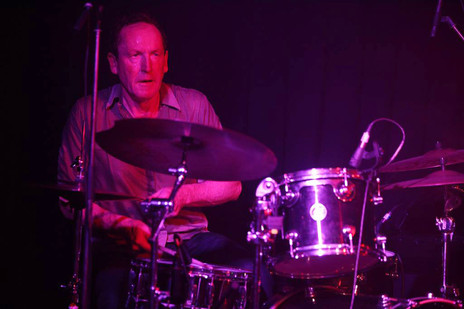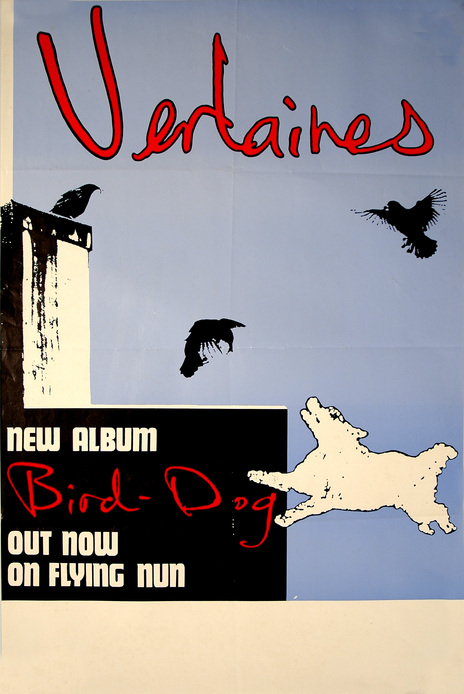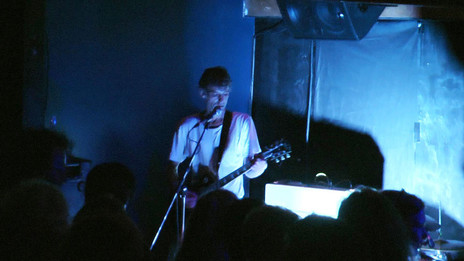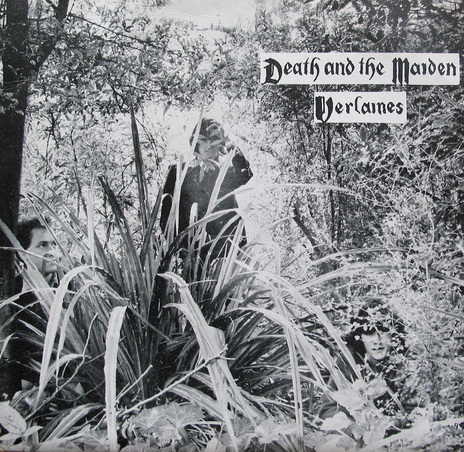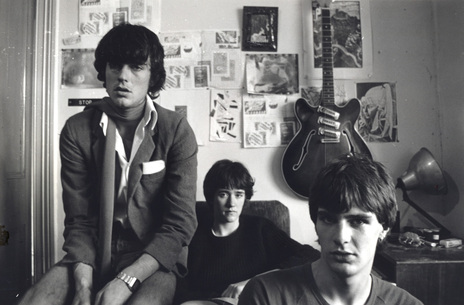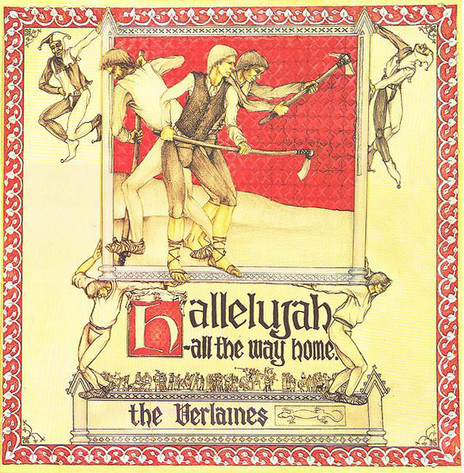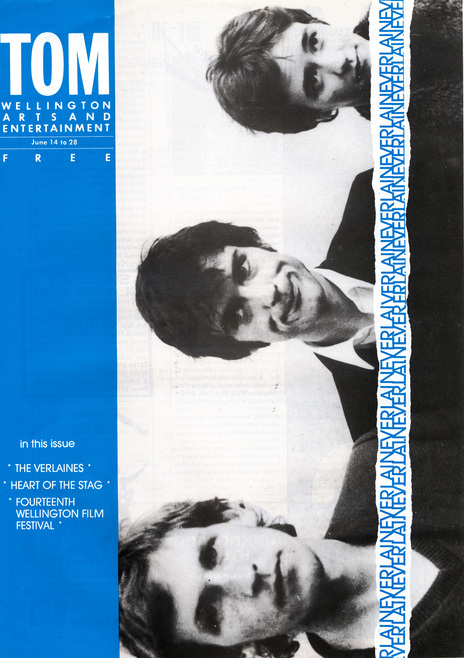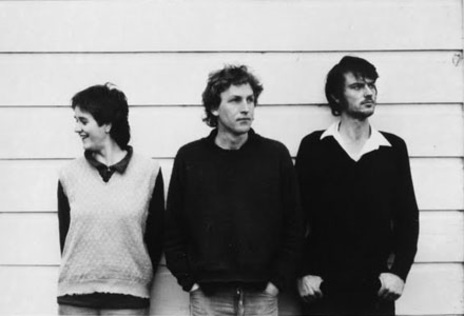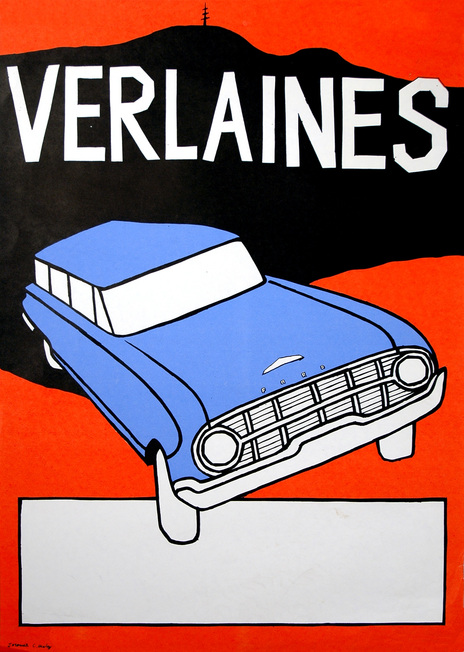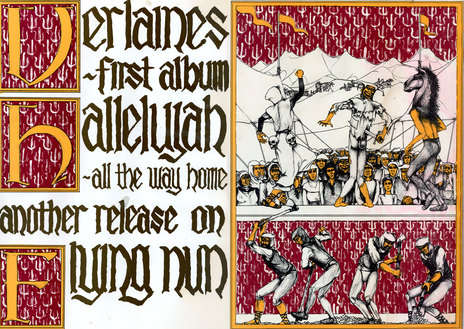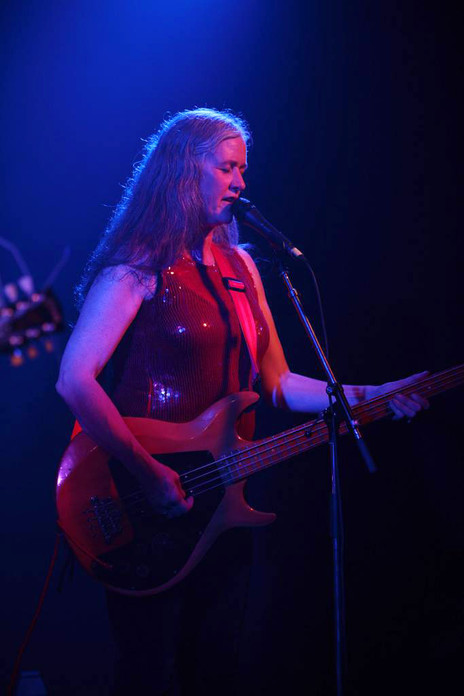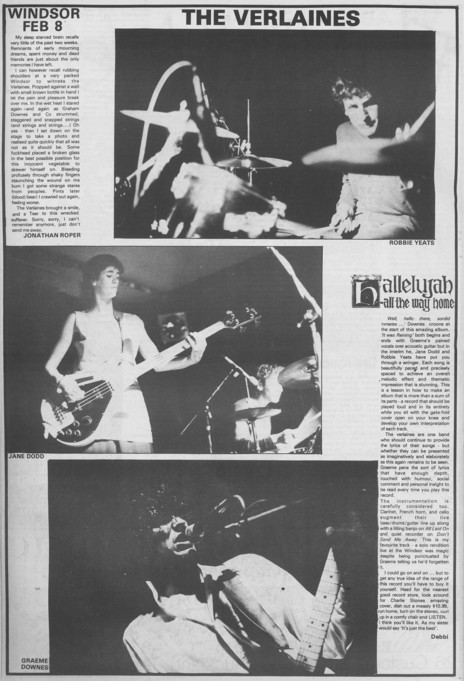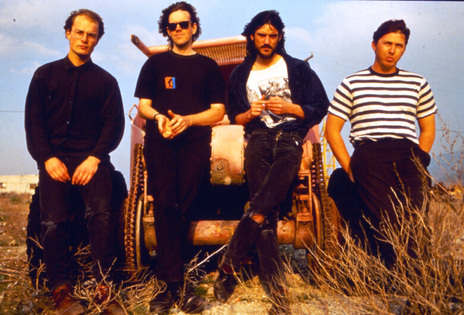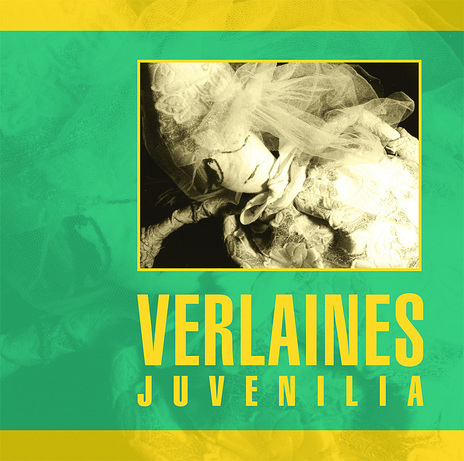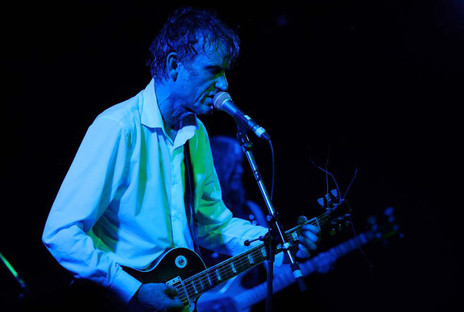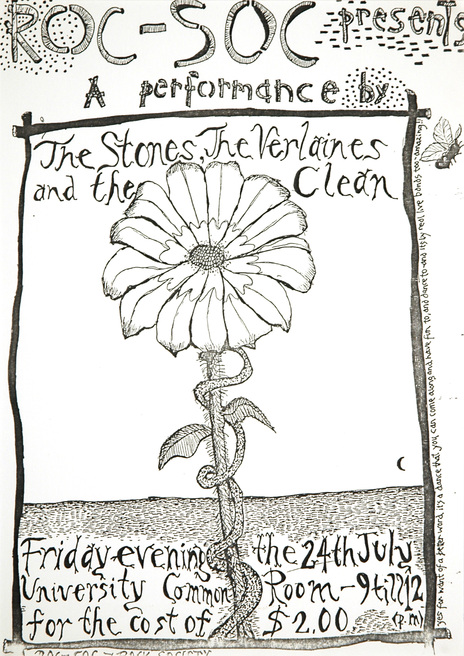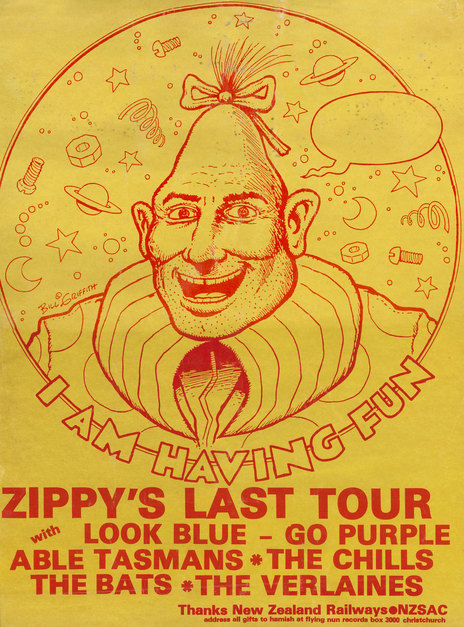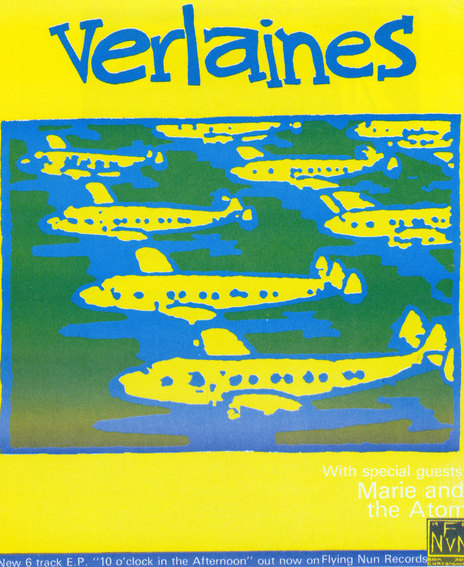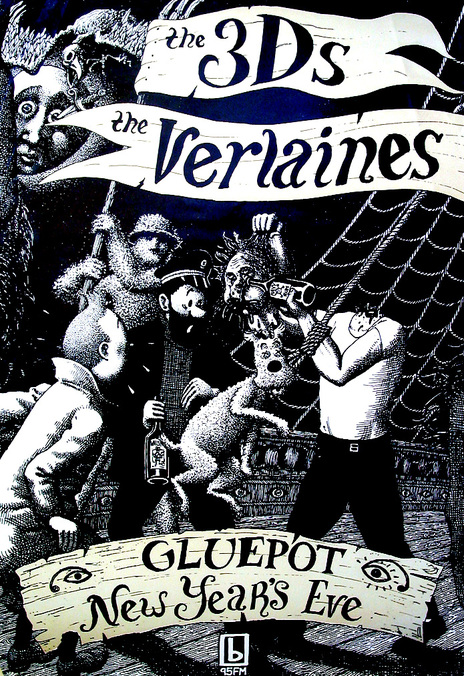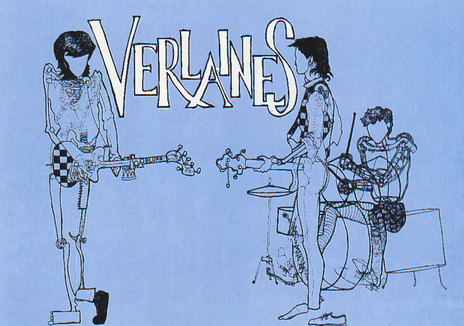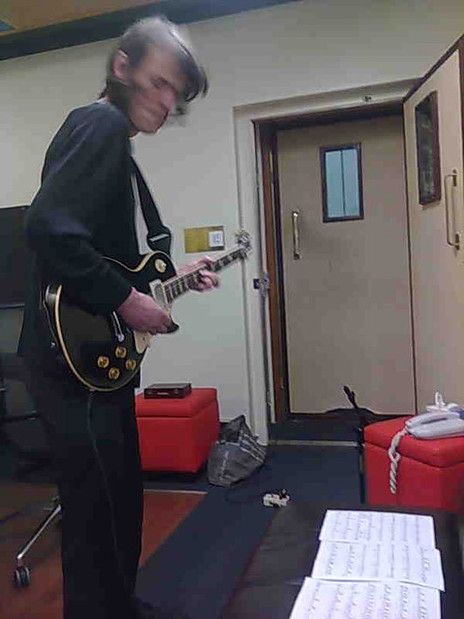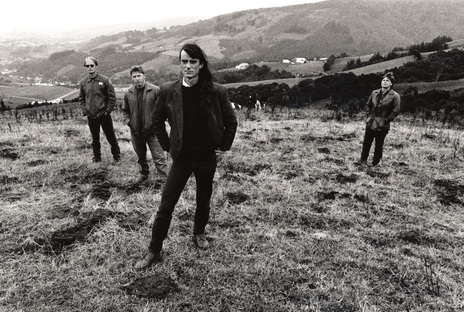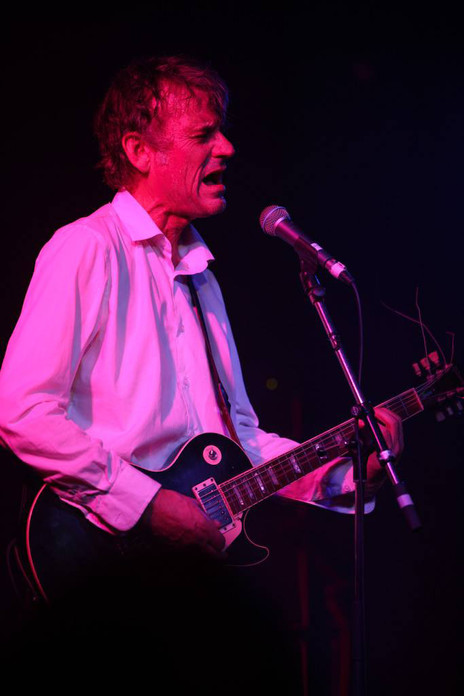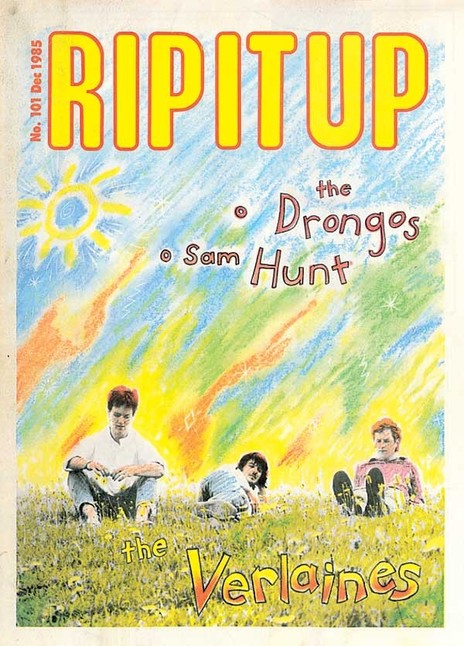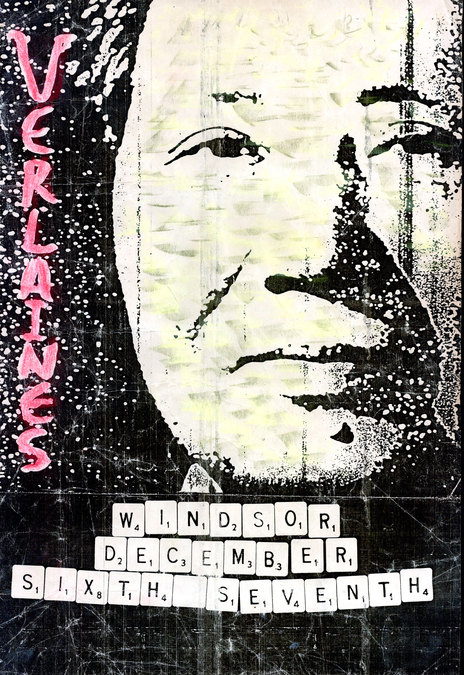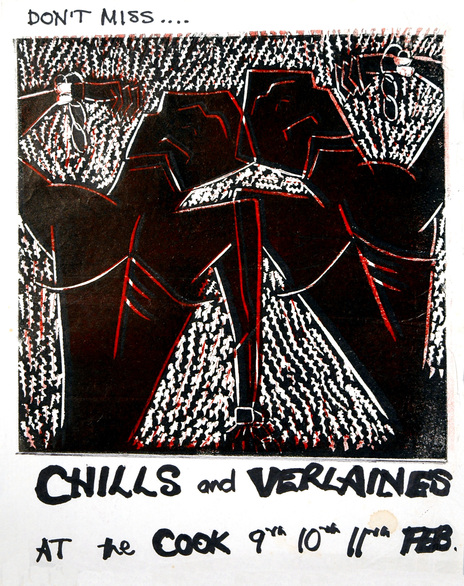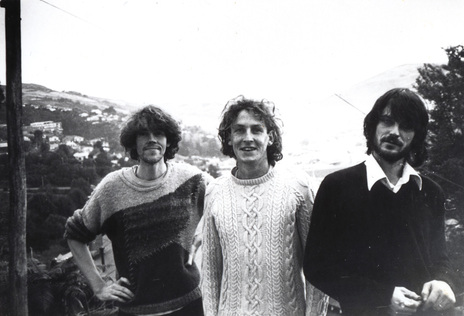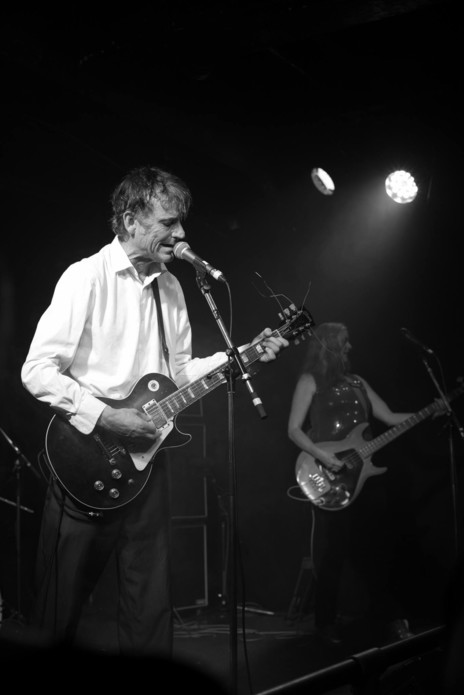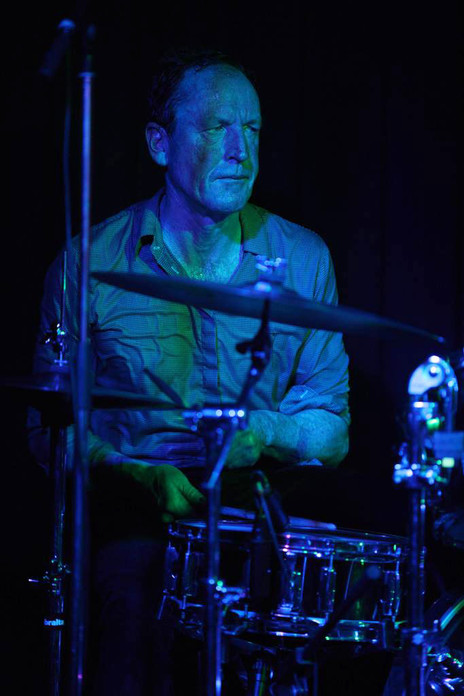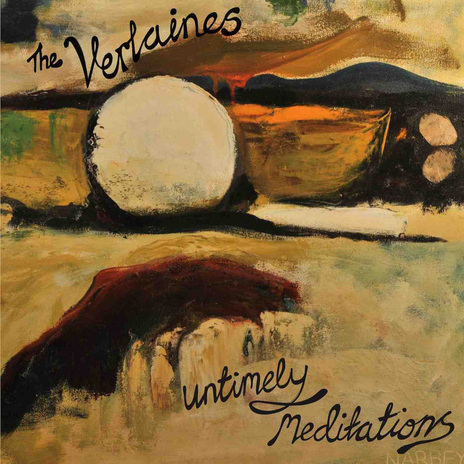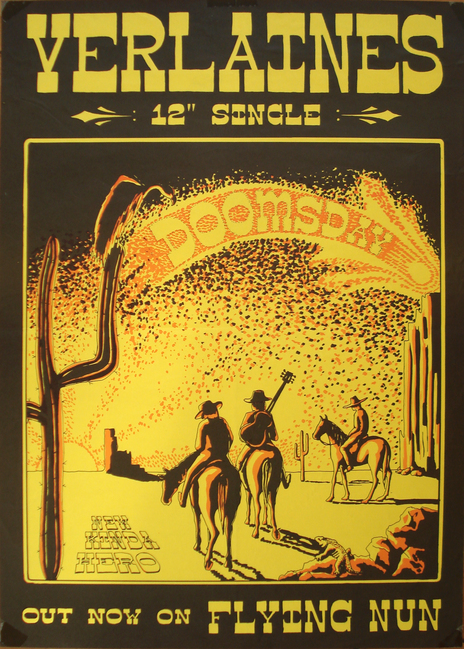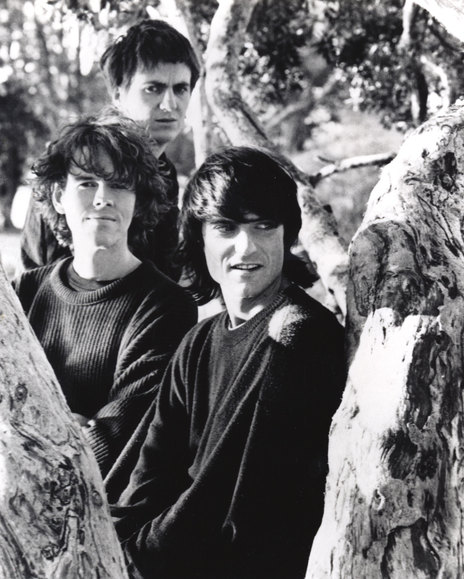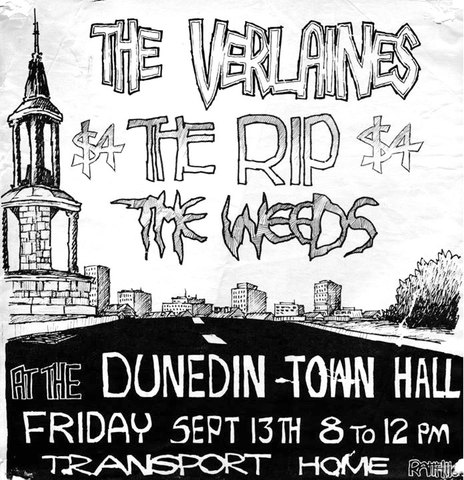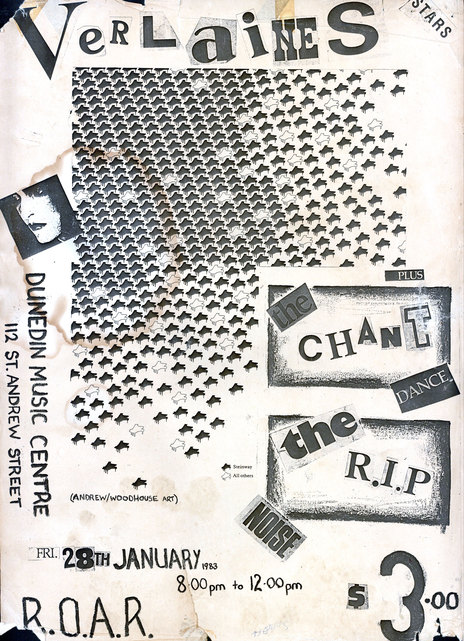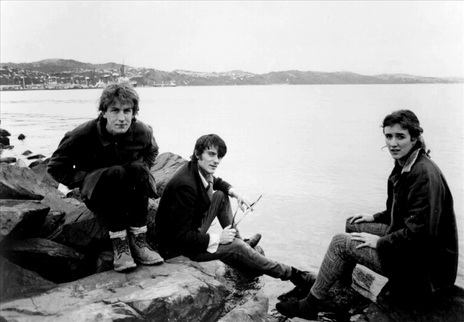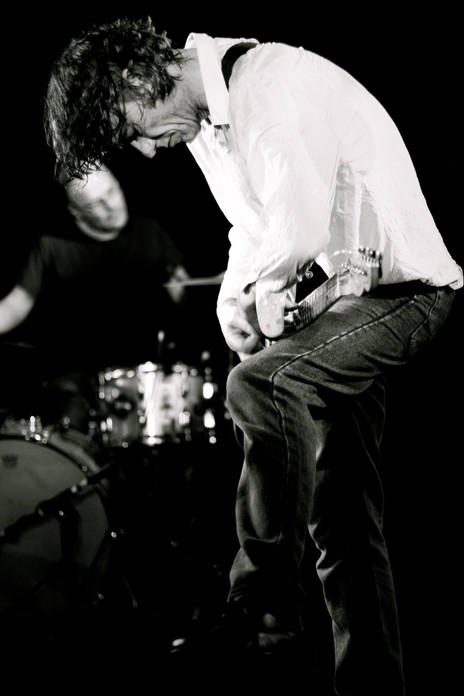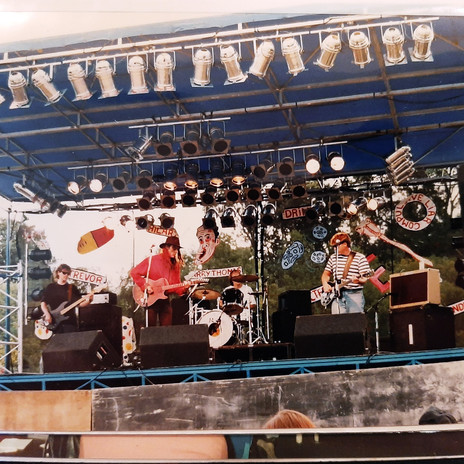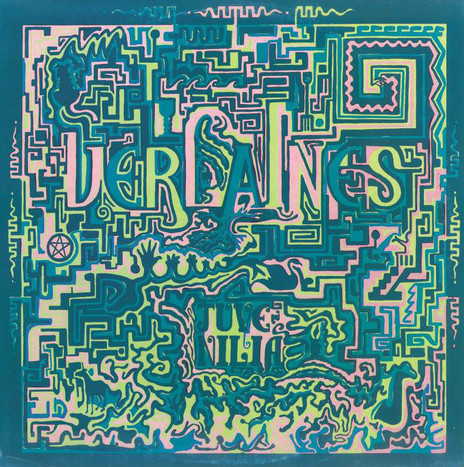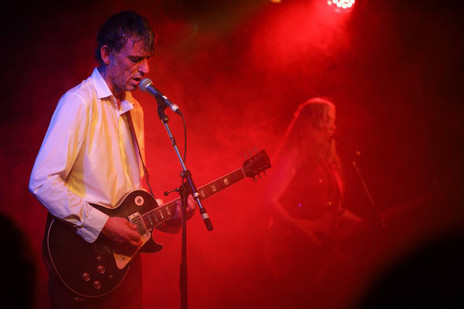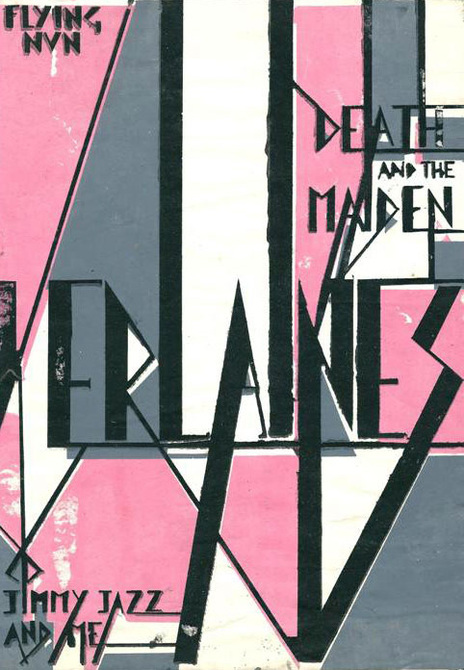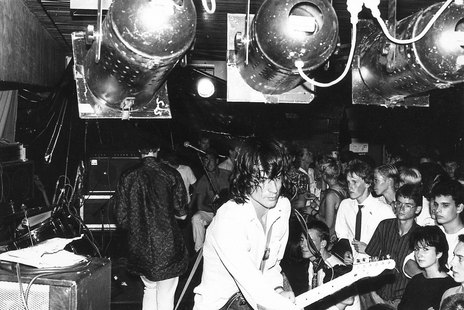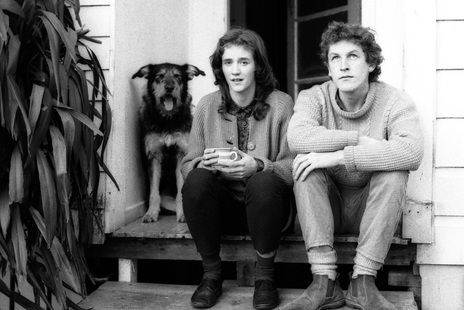A grey-toned photo sleeve of the trio hiding in a garden and a lyric insert in gothic script complete the package and evoke the grey stone architecture of the city and the University of Otago’s original buildings and tree-lined campus.
The ‘Death And The Maiden’ video is just as revealing. In it, The Verlaines – singer-guitarist Downes, bassist Jane Dodd and drummer Alan Haig – perform in a large, sunny bay-windowed room, and on a derelict building, amid a carousing throng of musicians from the rising Dunedin scene in layered op-shop finery. Jeff Batts of The Stones, a good chunk of Look Blue Go Purple and The Chills’ Martin Phillipps are there, among others.
It was an early mass introduction to some of the main protagonists of what was already called the Dunedin Sound. They knew each other well, having come together as rock music loving teens at North Dunedin high schools, provoked by punk and fired up by The Clean, the Dunedin post-punk trio who showed them the way. Strays, gathered up from New Zealand’s provincial towns and cities, ostensibly in Dunedin to study, swelled and completed the group.
The South rising
The Verlaines first stirred in late 1980. With the city’s young groups, they began organising hall concerts, playing one-offs at Dunedin Town Hall’s concert chamber, and on campus for the Otago University Rock Society. From the middle of August 1981, the emerging groups were filling out bills in the newly opened concert venue on the third floor of the Empire Tavern in Princes Street. Most weekends well into 1982, that’s where you’d find The Verlaines’ early line-ups with Downes, Phillip Higham (bass), Craig Easton (guitar, vocals), Greg Kerr (drums) and keyboardist Anita Pillai.
Hometown fans got the full Dunedin sound menu of The Verlaines, The Clean, The Chills, The Stones and Sneaky Feelings.
Trips north to Christchurch in October and November 1981 to play the DB Gladstone with The Clean and Sneaky Feelings introduced The Verlaines to new crowds and garnered mixed notices. Hometown fans lucked out and got the full Dunedin sound menu of The Verlaines, The Clean, The Chills, The Stones and Sneaky Feelings at the Captain Cook tavern for a four-day run in mid-December. The Verlaines were back in Christchurch in March 1982 with Sneaky Feelings at the Star and Garter, pausing long enough to record songs for the Dunedin Double EP.
When the landmark Flying Nun compilation was released in July 1982, it shifted the gaze of indie fans to the far south. The Verlaines have three recordings on it, none especially distinguished, although the songs are there. ‘Crisis After Crisis’ in particular, was promising. It’s the song Downes later pointed to as a clear link in the Dunedin Sound chain.
Downes: “[You can] put together a join-the-dots line from The Clean’s ‘Platypus’. Essentially ‘Crisis After Crisis’ is my rewriting of the same song. Then you go to Sneaky Feelings’ ‘PIT Song’, their rewriting of ‘Crisis After Crisis’, which is the big ABA structure within the song, which is quite unusual. They are not sound ideas, they are poetic ideas, the way of proceeding.”
The Dunedin Sound
It’s impossible to write the story of The Verlaines without dealing first with the spectre of the Dunedin Sound – the enduring idea that a musically unique movement arose in the lower South Island city in the early to mid-1980s. Downes, The Verlaines' singer, guitarist and composer, remains one of the chief proponents of the idea. His band, not surprisingly, are the group who best fit the description.
Downes is a born and bred Dunedin-ite who has only left the city to live once (in Auckland) around the turn of the millennium. He draws his bandmates solely from the southern centre. In the 1980s, especially the early years, The Verlaines played frequently with The Stones, Sneaky Feelings, The Chills, The Blue Meanies and The Rip, finding some early members in their ranks. Downes’s services as arranger and musician also found a ready outlet in his fellow bands, if needed.
In Dunedin Soundings: Place and Performance (2011), Downes, now a senior lecturer and head of Otago University’s music department, provides the sharpest definition of the Dunedin sound. “It is undeniable,” he says, “That certain Dunedin bands of that era (The Clean, The Verlaines, The Stones and The Chills, for example) projected a similar sound: trebly, highly reverberant guitars and partial barre chords with jangling or droning open strings.”
He points also to similarities in song form at odds with prevalent song structures and a tendency to “pure musical discourse” through “large instrumental sections (which) convey or amplify poetic ideas nascent in the song’s text” – further arguing that the sounds filling those irregular structures are drawn from a “stylistic pool containing folk music, urban white rock (anything from The Beatles to The Velvet Underground) and classical music (both of the Western variety and, possibly, via the orientalism of The Beatles and the Velvets, Indian).” Influences which were present and available to all the Dunedin groups.
Talking to the bFM’s Flying Nun Extended Play radio series in 2012, Downes expands his explanation to include the use of keyboards – “authentic sounding sixties organs” – and the need for a modified local identity to fit the cultural and political turmoil of the 1980s and 1990s in New Zealand.
Death And The Maiden
The Verlaines and Sneaky Feelings headed for Auckland in August 1982 to capitalise on the buzz generated by the ‘Dunedin Double’.
Hard on the heels of an omnibus first anniversary showcase with The Rip, Blue Meanies, Sneaky Feelings, The Chant, The Stones, and a reformed Bored Games at the Empire in late July, The Verlaines and Sneaky Feelings headed for Auckland in August 1982 to capitalise on the buzz generated by the Dunedin Double. Former Chills bass player Jane Dodd was now on board, having joined just before their initial recording session.
Indie Auckland welcomed the new groups at The Reverb Room, Windsor Castle, and the larger Mainstreet Cabaret on August 19 on a bill with Nocturnal Projections and Coloured Pencils. Then it was back into the studio, The Lab this time, to capture ‘Death And The Maiden’ and ‘CD, Jimmy Jazz And Me’. On the way home, the Dunedin double stopped in at Cosgroves in Wellington and The Gladstone in Christchurch.
The arrival of ‘Death And The Maiden’ in July the following year removed any lingering doubt in fans’ minds as to The Verlaines’ worth. While never a hit in the chart sense, the song wormed its way into the indie consciousness. Reviewers constantly singled it out on compilations, including Flying Nun Records’ impressive, label-defining compilation Tuatara. Any doubts Downes had over his vocals – he never intended to be the singer – soon disappeared.
10 O’Clock In The Afternoon
The Verlaines were back in Christchurch in February 1984 with The Chills at Hillsborough Tavern before heading north for Wellington. They were back at the Gladstone in early March with The Great Unwashed. Auckland shows at Limbs studio, Windsor Castle and The Gluepot beckoned in late April. Easter break in Auckland was spent recording a standalone EP at the “small and quite humble” Progressive Studios with Terry King and Doug Hood. Two weekends at The Windsor Castle in May complete their extended northern stay.
‘10 O’Clock In The Afternoon’ found The Verlaines marrying a wordy, punk-energised guitar sound to classical structures.
Housed in a Jane Dodd-designed green, black, white and purple mosaic cover, 10 O’Clock In The Afternoon found The Verlaines marrying a wordy, punk-energised guitar sound to classical structures. Standout tracks are ‘Pyromaniac’, ‘You Say You’ and Downes’s best composition yet, ‘Joed Out’. In common with all The Verlaines’ songs, the tracks were scored out in advance by Downes, utilising his oboe and violin, and organ from Jane Dodd, whose backing vocals are a vital part of the trio’s mix. For all the art-minded purpose on display, Downes still describes the EP as “creativity on the fly, no pre-production, no demoing of songs.”
Turn the EP over and you find a photo of Downes, Dodd and new drummer Robbie Yeats, who has replaced Caroline Easther. They are standing and sitting among leafless trees beside the Leith river on Otago’s campus.
Wind that reel back a bit, yes, that’s Yeats on drums. Band interviews in years to come will enquire after Verlaine (Paul or Tom?), but no-one ever asks about having a drummer called Yeats, one of the poets Downes actually likes. Whereas the Frenchman was but a passing fancy.
Pyromaniac
With 10 O’Clock in the Afternoon, The Verlaines delivered one of the finest local 12-inch EPs in that medium’s finest hour. Their fans certainly thought so, pushing it to No.23 in September 1984 in an eight-week chart stay. Videos for ‘Pyromaniac’ and ‘Wind Song’ helped, as did an extensive North Island tour in July that took in Wellington, Palmerston North, Ohakune, New Plymouth, Hamilton, Auckland and Whangarei. Yet another indication of the trio’s swelling fan base.
Not that The Verlaines really noticed. Jane Dodd: “[We] didn’t consider audience and market – the norm and us was so widely diverging – we just didn’t consider it. It meant we could go to Auckland and get 400 people into The Gluepot. Student radio was going so we got a little bit of airplay support.”
The Verlaines concluded their busiest year so far quietly at The Captain Cook in September and The Gladstone in November and December.
Hallelujah All The Way Home
The popular momentum which the band gathered in 1984 was still alive and kicking in 1985. Working their tours in around study – as they would for the following years – the Dunedin trio was back in Auckland with The Chills and Look Blue Go Purple in February, dropping into Massey University and Canterbury University and Wellington’s Pulse on the way home. May holidays saw them in Christchurch, Wellington and Auckland, where they opened for New Order at the Logan Campbell Centre, and began recording Hallelujah All The Way Home, their debut album.
With Graeme Downes well into his classical music degree at Otago University, the time had come to bring his classical and post-punk worlds more fully together. He’d already arranged strings and horns for Sneaky Feelings, “scoring parts out, old school at the piano with manuscript and hoping what you’d written would turn out okay on the day when you got the real player in to play it.”
“There is a lot of potential for assimilating classical elements into rock music,” Downes would later elaborate, “I don’t mean 70-piece orchestras playing half-hour songs. I’m thinking in terms of harmonies, structures and types of melody. There are some styles of music that haven’t been touched by anyone working in a more ‘popular’ context.”
With that in mind, The Verlaines captured Hallelujah All The Way Home with producer Phil Yule at Mascot Studios in May and June 1985. For fans of Downes’s hard-strummed symphonies, there is the jangly punk power of ‘Lying In State’, a track untypical of the album. The bulk of the record is dry, almost arch, compositions augmented (but not yet driven) by clarinet, cello and horn – the middle-range classical instruments Downes felt confident enough to use. Despite such fan favourites as ‘For The Love of Ash Grey’, ‘Phil Too’ and ‘It Was Raining’ seaming the new work, it barely made the charts in January 1986.
Downes told bFM’s Flying Nun Extended Play in 2012, “What I was trying to do was more emotive and dramatic. I needed to learn how to change key and that is the difference between ‘You Say You’ (on 10 O’Clock), which is essentially all in D, and something like the ‘Ballad of Harry Noryb’, which is of a similar proportion, but uses all sorts of different key changes – same intent, but on a higher level. The same could be said of ‘Baud To Tears’, which is unusually structured, but again, its all in D, compared with ‘It Was Raining’, which changes key.”
Downes presented THE ‘Hallelujah’ LP to his university supervisors, receiving a high mark.
On release in the UK in 1987, NME’s Nick Coleman wrote that the LP “… at first sounded like a motley collection of rural Velvet Underground drones [but] is in fact an album of snake-subtle tunes about drinking, drinking, drinking and the socio-historical perspective on the myth of love.”
At home in Dunedin, Downes duly presented Hallelujah… to his university supervisors, receiving a high mark. Then it was back on the road in February, May and August 1986.
Doomsday
In late November 1985, The Verlaines recorded ‘Doomsday’ and ‘New Kinda Hero’ for a 12-inch single, which they finished off in February 1986. The end result swung and swooned at a fast-strummed clip and edged into the charts in September 1986, where it stayed one bare week, peaking at No.37.
A video of ‘Doomsday’ was filmed for children’s show What Now! after MOR music show True Colours turned the group down. ‘Doomsday’ deserved better. It was cut from the same cloth as ‘Joed Out’ with words that stuck in the head and a trebly guitar groove and rhythm that sang. Problems getting the record’s small run pressed further delayed and stymied the record’s impact.
Bird Dog
Of all the Dunedin groups, The Verlaines had the longest emotional reach, musically and lyrically. There was always more there than you first heard. On their second album Bird Dog, with its richly coloured John Collie-painted cover, The Verlaines showed it beyond a doubt with a full album’s worth of post-teen anthems in the trio’s classical-cum-punk via Television style.
The list of truly great Flying Nun Records albums isn’t long, but Bird Dog will always find a place near the top. Class songs jam the track listing, which builds beautifully, through smart track sequencing and a surer sense of the dynamic that classical instrumentation can bring, as the revisit of ‘CD, Jimmy Jazz And Me’ ably demonstrates.
THE NME praised ‘Bird Dog’, citing Television and The Go Betweens as recognisable influences.
Recorded at Mascot Studios in August 1986 and March 1987, Bird Dog rode out a turbulent time in New Zealand’s record industry as the country’s remaining pressing plant closed down. Faulty masters further delayed its New Zealand release until late 1987, which frustrated, but didn’t inhibit fan reaction. John Tague in NME praised it, citing Television and The Go Betweens as recognisable influences.
Australian journalist Shaeffer found Bird Dog “Steeped in subtle nuance, encased in swoops and dives of tempo, Graeme’s whispered scream crosses a range of musical backdrops – ‘You Forget Love’ comes replete with celestial choirs, ‘Icarus Missed’ thinks it’s a pagan hymn, and ‘Bird Dog’ is a curious hybrid between a folk song and beer hall chant.”
Further into their interview, Downes explains. “I am not world weary or bitter, my work is confrontational and defiant, not self pitying. It’s a sort of study in the anatomy of depression. In all the songs I am facing problems, dissecting, sorting, so the final result is hopefully triumphant.” Depression, melancholy, isolation: they have always been there in his work, although the songs remain ultimately uplifting.
Juvenilia
The Verlaines played their first overseas shows in Australia in mid-1988 on the back of Bird Dog’s solid airplay on Sydney’s Triple J. With Jane Dodd living in Auckland and Bird Dog mopping up what remained of The Verlaines unrecorded back catalogue, a line-up change was inevitable. Radio One engineer Mike Stoodley was the new bass player, and The Verlaines’ international phase began in earnest. Their albums were now released in Great Britain (thru Flying Nun UK), Europe (thru Flying Nun Europe) and America (thru Homestead Records).
Early adopters aside, American, European and British fans got their first prolonged exposure to The Verlaines sound through the well-received Juvenilia, which gathered up their Dunedin Double tracks (including a remixed ‘You Cheat Yourself’) with the ‘Death And The Maiden’ single and 10’Clock in The Afternoon EP in 1987. The second album they could buy was Bird Dog (1987 in Europe and England and 1988 in the US), followed by the first LP with Stoodley, Some Enchanted Evening (1990).
The wider indie world The Verlaines found was welcoming and not unfamiliar.
The wider indie world The Verlaines found was welcoming and not unfamiliar. As in New Zealand, tertiary student populations were robust in the 1980s and 1990s, fostering indie music through student radio stations and publications that organised and publicised concerts, featuring the new groups.
Many of the musicians involved in alternative scenes were (or had been) students active in the wider associated indie milieu. As they began to network, they found their form of cultural activity was happening everywhere in the western world. Great Britain and Europe were welcoming, but it was in America in the late 1980s and early 1990s that The Verlaines found enduring interest.
While the sounds produced often differed between scenes, the environments they were made in were similar. Many of the new indie groups and labels were based in student cities such as Raleigh in North Carolina, Athens in Georgia, and Seattle in Washington. Most big city punk and post-punk scenes were actually urban colonies within a bigger whole. It wasn’t a big mental step for fans attracted by music and groups from out of the way or marginalised places to engage with sounds from the seemingly even more remote Dunedin. An engagement profound enough to leave a cultural footprint, which endures to this day.
Some Disenchanted Evening
Album number three, Some Disenchanted Evening, was recorded in Auckland in January and February 1989, following The Verlaines’ Sonic Youth support slot at The Powerstation. Downes still had some standout tunes left in ‘Jesus, What A Jerk’, ‘Whatever You Run Into’, ‘Down The Road’ and ‘Anniversary’. It was also their last album for Flying Nun Records until 2007, outside of the New Zealand release of Juvenilia in 1993.
In September 1989, prior to their first American tour in October, which took in a frat house at Princeton University and a Halloween Ball in Toronto, Robbie Yeats left The Verlaines. His awkward, apt beat would be missed. The Alpaca Brothers and Trash’s Steve Cournane replaced him.
With manager Jo Downes, The Verlaines were back in Sydney in May 1990 to promote Some Disenchanted Evening, gathering favourable reviews in local media for a record that Graeme Downes credits as having more variety and percussive complexity than previous releases.
Ready To Fly
It’s the middle of 1991, and The Verlaines, with new drummer Gregg Cairns behind the kit, have a secret. They’re negotiating with LA indie Slash Records, having captured demos for new album Ready To Fly at Radio One’s 16-track studio in mid-1990. A seven-album deal results.
The Verlaines opened another front in the NZ indie onslaught, on the booming U.S. college radio circuit
Joining The Chills at Slash Records, The Verlaines opened yet another front in the New Zealand indie onslaught on US college radio, a medium which was booming, aided by live showcases such as New Music Seminar in New York and the emerging South By South West (SXSW) carnival in Austin, Texas. Nationally distributed music periodicals, including Spin and Option and a mass of smaller music media, were also vital in spreading the word.
The Verlaines recorded Ready To Fly properly in a Sydney studio in July with engineer Victor Grbic. Having sat with the demos so long, they self-produced it.
For Downes, it’s another work in a long line of related endeavour. “Bird Dog still gets lauded in the States due to the novelty of how overt the added sounds are,” he explains. “The intention has always been to use extra instruments where they were going to add something as opposed to bury something else. Bird Dog went too far in one direction. Some Disenchanted Evening jerked back towards the jug band, folk influence. I think we got it just about right this time.”
Ready To Fly was also a record that sparked tension with New Zealand indie fans and Flying Nun Records. Unlike The Chills and Straitjacket Fits, The Verlaines had signed exclusively to Slash, which was distributed in Australasia by Festival Records. When the New Zealand indie label staged its 10th anniversary celebrations in 1991, The Verlaines were conspicuously absent. It didn't help that Ready To Fly was released in the US four months before its NZ release in early 1992. Downes soon found fault with the record himself, complaining about the “small” sound of the guitars.
Way Out Where?
By 1993, Downes was finally free of university study. The previous year, Rip It Up found him at home in Dunedin fine-tuning his doctorate on Gustav Mahler. So it was Dr Downes who recorded The Verlaines’ fourth album Way Out Where with Joe Chiccarelli in a North Hollywood studio. Boosting the trio’s guitar sound was new recruit Paul Winders. The departure of Gregg Cairns also brought Darren Stedman into the group, beginning the longest tenureof any band member.
In the sprawling metropolis they met up with Straitjacket Fits who were staying at the same motel. The Verlaines also found time to record ‘Heavy 33’ for the big-selling No Alternative album, an AIDS fundraiser: a cause to which, in 1995, Downes donated a take on Doublehappys’ ‘Some Fantasy’ for the Red Hot + Bothered compilation.
If that wasn't enough, there was a New Zealand tour in April 1993 promoting the belated release of Juvenilia, featuring older songs left out of their set for a while. Mike Stoodley then departed in 1994 and was replaced by Russell Fleming on bass for 1997’s Over The Moon for Columbia Records.
Legacy Act
Like their primary influence The Clean, The Verlaines never really ceased. The late 1990s and the following decades saw them venture out live with some regularity. They returned to Australia’s east coast in January 2011 for Melbourne and Sydney dates, including Laneways sideshows in the Sydney Opera House Concert Hall.
They also made available a steady stream of albums. A solo Graeme Downes album, Hammers And Anvils, for Matador in 2001; Pot Boiler, for Flying Nun Records in 2007; the overtly political Corporate Moronic in 2008, and Untimely Meditations (Flying Nun Records) in 2012. They need some sifting, but there’s plenty of intriguing material to be found, including ‘What Sound Is This?’ from a soundtrack for the film Eden.
On Record Store Day in 2020, the 19-track Dunedin Spleen double-LP was released. “A new Verlaines album always means sophisticated songwriting and musicianship, which Dunedin Spleen has in buckets,” wrote NZ Musician. The album’s “urgency frequently matches the visceral classics from the band’s early years, and shows Downes (and The Verlaines) at their melodic, and intricate, best.”
In 2021 Dr Graeme Downes was made a Member of the New Zealand Order of Merit for services to music and music education.
--
Read more: Russell Brown interviews The Verlaines, 1985
Read more: Graeme Downes, profiled by Graham Reid
